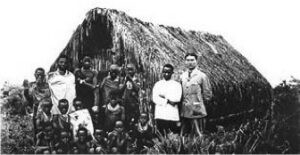
Missionary teacher with African students.
It was the missions who first started education for the African population during colonial times in Kenya, because education was essential for their evangelical work and the training of Africans to take up proselytising. In the early days education varied from mission to mission because there was no government department to co-ordinate it until 1911. So the missions established their own the board of education in 1908 and by 1913 they had adopted a uniform code regarding translations and school textbooks in order to avoid duplication. It was not until 1909 that the government set up the first non-mission schools for Africans, mostly in areas where the missions had the least influence – Kitui (1909), Machakos (1914), Narok (1918), Kajiado (1925), Kericho (1924), Kapsabet (1925), Tambach (1926) and Kapenguria (1929). They taught technical and agricultural studies. Machakos taught carpentry, masonry and tailoring to the Akamba and Kipsigis, while Kapenguria and Tambach introduced modern agriculture to the West Suk, and Kajiado and Narok taught the Maasai to be ghee makers and milkers.
During World War I Africans’ reluctance to attend school was reversed, partly because participation in education was a means to avoid recruitment to the government’s forced labour service. After the war the Kikuyu people in particular showed great interest in education because the expanding economy was giving them more employment opportunities. In the 1920s the Kikuyu Association and Local Native Councils began to demand high schools for Africans, because mission education was only at a basic level.
An Education Commission had been set up in 1919: its guidelines were that missions should provide a basic literary education up to the age of 11, and technical education for those aged 12 to 18. But Africans resented technical education as inferior to academic education. The missions were given grants-in-aid for technical education. Some missions rejected this because they were primarily interested in spreading the gospel or thought that only God should provide funds. But the Church of Scotland Missions, Church Missionary Society and Catholics accepted the money. The future of African education in Kenya changed in 1924 when the government acquired complete control of all mission education. The curriculum was standardised and schools were to be inspected.
The Native Industrial Training Depot (NITD) was established in 1925 and Alliance High School and Jeanes School were begun in 1926. But these were not academic schools, for there was a fear that such schools could be a breeding ground for political activism. This indirectly led to the establishment of the Kenya Training College at Githunguru, which the government was tricked into thinking was a primary school until a board was hoisted during its opening ceremony, leaving government officials severely embarrassed. There was unprecedented educational growth among the Kikuyu in the 1930s. By 1935 there were over 50 licensed independent schools in central province with about 2,500 pupils.
The aim to make Africans industrial and agricultural workers rather than professionals did not in fact prevent the development of academic awareness and political aspiration, for it was the products of these schools who set up welfare and political associations among Africans. Educational demands became insistent after World War II, when there were only 395 secondary school pupils, and just two were girls. In 1948 the Kenya government drafted a 10-year plan for education: “to provide within 10 years a full course under qualified teachers for approximately 50 per cent of the children of school age, and to ensure that there shall be an adequate supply of trained teachers and a satisfactory number of pupils of both sexes to secure adequate education up to and including secondary school level.” There would be 2,000 primary schools for a four-year course for the age group 7 to 11 years, and 340 intermediate schools for a two-year course for the age group 11 to 14 years and the intake at the age of seven should be about 180,000 pupils. There would be district education boards with the district commissioner as chairman, the education officer as second executive officer, four African members and four other members, missionaries nominated by the provincial commissioner. This was a start, though it did not meet all the demands of African leaders.

Recent Comments